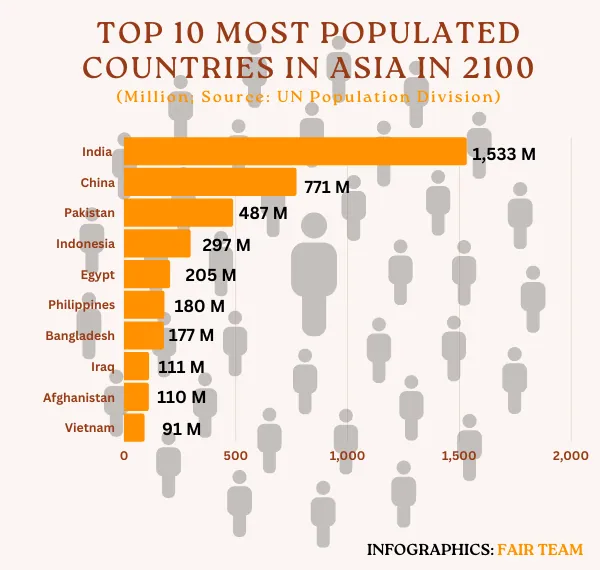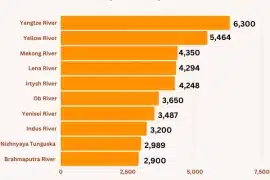As the world’s largest continent, Asia is home to a diverse range of cultures, traditions, and, most importantly, populations. The global population is projected to rise significantly in the coming decades. It is fascinating to explore the estimated population figures for Asia’s most populous countries in the year 2100. According to the projections by the United Nations Population Division, the top 10 most populated countries in Asia in 2100 will be India, China, Pakistan, Indonesia, Egypt, The Philippines, Bangladesh, Iraq, Afghanistan and Vietnam
List of the top 10 most populated countries in Asia in 2100
India: 1,533 million
India, often referred to as the world’s largest democracy, will maintain its position as the most populous country in Asia in 2100. With a staggering estimated population of 1,533 million, India’s population growth reflects its current upward trend, fueled by factors such as high birth rates and improving healthcare.
China: 771 million
China, currently the most populous country globally, will experience a decline in population by 2100. Despite this, it will remain the second most populous country in Asia with an estimated population of 771 million. China’s demographic shift depends will depend on several factors such as a declining birth rate, an aging population, and government policies.
Pakistan: 487 million
Pakistan, known for its rich history and cultural diversity, will become the third most populous country in Asia by 2100. With a projected population of 487 million, Pakistan’s growth will continue due to high fertility rates and a large youth population.
Indonesia: 297 million
Indonesia, an archipelago comprising thousands of islands, will rank fourth in terms of population in 2100. With an estimated population of 297 million, Indonesia’s growth is fueled by a combination of factors including a large young population, urbanization, and economic development.
Egypt: 205 million
Egypt, a nation renowned for its ancient civilization and cultural heritage, will be the fifth most populous country in Asia in 2100. With an estimated population of 205 million, Egypt’s growth reflects its current demographic trends and the challenges of balancing population dynamics with socioeconomic development.
Philippines: 180 million
The Philippines, known for its stunning natural landscapes and vibrant culture, will rank sixth in terms of population in 2100. With an estimated population of 180 million, the Philippines’ growth can be attributed to a combination of factors including high birth rates and improved healthcare access.
Bangladesh: 177 million
Bangladesh, a country with a rich cultural heritage and a history of resilience, will be the seventh most populous country in Asia by 2100. With an estimated population of 177 million, Bangladesh’s growth is influenced by factors such as high population density, fertility rates, and ongoing development efforts.
Iraq: 111 million
Iraq, a nation with a significant historical and cultural legacy, will rank eighth in terms of population in 2100. Iraq’s growth reflects its demographic trends and the ongoing process of rebuilding and development.
Afghanistan: 110 million
Afghanistan will become the ninth most populous country in Asia by 2100. The growth will be influenced by factors such as high birth rates, ongoing conflicts, and the pursuit of stability and development.
Vietnam: 91 million
Vietnam, a nation renowned for its picturesque beauty and cultural heritage, will rank tenth in terms of population in 2100. With an estimated population of 91 million, Vietnam’s growth reflects a combination of factors including improving healthcare, economic development, and a young and dynamic population.
Summary of the top 10 most populated countries in Asia in 2100
According to the UN Population Fund, the 10 top most populated countries in Asia in 2100 will be:
- India, 1,533 million
- China, 771 million
- Pakistan , 487 million
- Indonesia, 297 million
- Egypt, 205 million
- The Philippines, 180 million
- Bangladesh ,177 million
- Iraq, 111 million
- Afghanistan, 110 million
- Vietnam , 91 million
These projected population figures provide valuable insights into the region’s changing demographic landscape. Undoubtedly, these projections are subject to various factors and uncertainties, including changes in fertility rates, mortality rates, and migration patterns. Nevertheless, these projections offer a glimpse into the potential future population dynamics in Asia.
Moreover, the anticipated population growth raises important considerations in terms of infrastructure development, healthcare systems, and sustainable resource management. It also highlights the need for proactive measures to address the challenges and opportunities associated with a growing population. These challenges include urbanization, employment, and social welfare.








